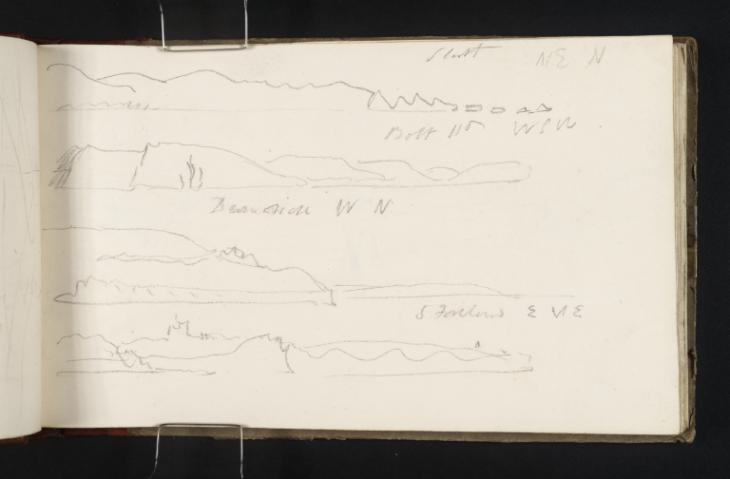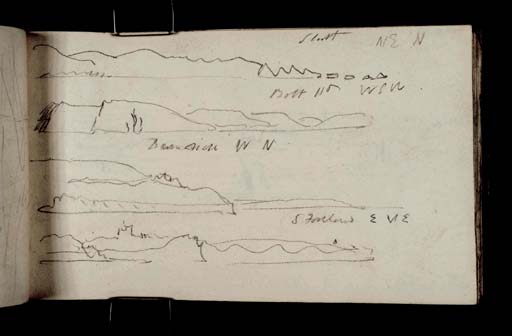Joseph Mallord William Turner Views of the English Coast c.1821-2
Image 1 of 2
Joseph Mallord William Turner,
Views of the English Coast
c.1821-2
Joseph Mallord William Turner 1775–1851
Folio 80 Verso:
Views of the English Coast c.1821–2
D17344
Turner Bequest CXCVIII 80a
Turner Bequest CXCVIII 80a
Pencil on white wove paper, 113 x 187 mm
Partial watermark ‘T Edm | 18’
Inscribed by Turner in pencil ‘Start NE N’ at top right, ‘Bolt Hd WSW’ towards top right, ‘Dunnose W N’ centre, ‘S. Foreland ENE’ towards bottom right
Partial watermark ‘T Edm | 18’
Inscribed by Turner in pencil ‘Start NE N’ at top right, ‘Bolt Hd WSW’ towards top right, ‘Dunnose W N’ centre, ‘S. Foreland ENE’ towards bottom right
Accepted by the nation as part of the Turner Bequest 1856
References
1909
A.J. Finberg, A Complete Inventory of the Drawings of the Turner Bequest, London 1909, vol.I, p.606, CXCVIII 80a, as ‘ “Start” Point,” “N.E.N.,” “Bolt Head,” “W.S.W.,” “......W.N.,” “S. Foreland. E.N.E.”.
The views on this page all come from plate 1 of The Little Sea Torch, an illustrated maritime text by Richard Bougard, translated from the French by J.T. Serres and published in London in 1801.1 For more detailed information about the publication, and an interrogation of Turner’s use of it, see the sketchbook Introduction. For a comprehensive list of the other pages in this sketchbook used for the same purpose, see the entry for folio 55 recto (D17296).
Turner renders these views in the same order as that in which they appear in the printed book. Most of Finberg’s identifications for the transcribed inscriptions are correct.2 First, at the top of the page, is a description of the topography at Start Point in Devon, in emulation of ‘The Start Point N.E.bN’.3 The sketch is inscribed at top right ‘Start NE N’. Earlier in the sketchbook Turner transcribes different views of this headland on folio 56 recto (D17298). For further information about the location see the entry for that page.
Next is a drawing inscribed with the identification ‘Bolt Hd WSW’. The direction from which the scene is actually taken deviates slightly from Turner’s inscription. The title given to the illustration of the Devon headland in The Little Sea Torch is: ‘The Bolt Head. W.N.W’.4 In almost all of the other examples of these copied compositions, Turner omits any sailing vessels depicted in his source material. Here, three angular markings in front of the second cliff face from the left seem to record the position of the ship displayed in the original illustration. Further studies of illustrations of Bolt Head feature on folios 56 verso and 57 recto of the current sketchbook (D17299, D17300).
Moving down the page, a third drawing describes Dunnose Point, a headland off the Isle of Wight in the English Channel. One of the highest points on the island, some of its peaks reach 792 feet.5 Rocks in the waters around Dunnose Point are notoriously treacherous, and in 1878 caused the infamous sinking of HMS Eurydice.6 The original illustration in The Little Sea Torch is third on the plate, with the title ‘Dunnose. W.bN’.7 Turner copies it more or less faithfully, including delineating a slice of chalk cliff midway up the foregrounded section of land.
The sketch across the bottom of the page describes Dover Castle and South Foreland, as expressed in the associated inscription: ‘S. Foreland ENE’. The composition is a copy of the fourth illustration on plate 1 of The Little Sea Torch, which bears the title ‘Dover Castle. N.E.½N’.8 At far right, the original engraving also labels the South Foreland headland in the manner of Turner’s inscription. In Turner’s copy on the present page, Dover Castle is delineated on the horizon at left, and the tip of the South Foreland lighthouse is visible towards the right. Both of these locations are explored elsewhere in this sketchbook. For comprehensive lists of South Foreland studies and pages which deal specifically with the lighthouse, see the entry for folio 8 recto (D17220). For Dover Castle, see the entry for folio 24 recto (D17247).
Maud Whatley
January 2016
Richard Bougard, The Little Sea Torch: or, True Guide for Coasting Pilots: by which they are clearly instructed how to navigate along the coasts of Malta, Corsica, Sardinia, and others in the Straits; and of The Coast of Barbary, from Cape Bon to Cape de Verd, trans. with corrections and additions by John Thomas Serres, London 1801. For an online and PDF facsimile, see ‘The Little Sea Torch’, Biblioteca Nacional de Portugal, http://purl.pt/23500 , accessed 26 October 2015.
‘Plate 1’, The Little Sea Torch, http://purl.pt/23500/1/index.html#/151/html , accessed 18 November 2015.
‘View of Dunnose from the Cliff near Shanklin in Sandown Bay, Isle of Wight’, The British Library, accessed 18 November 2015, http://www.bl.uk/onlinegallery/onlineex/kinggeorge/v/003ktop00000015u02700000.html .
How to cite
Maud Whatley, ‘Views of the English Coast c.1821–2 by Joseph Mallord William Turner’, catalogue entry, January 2016, in David Blayney Brown (ed.), J.M.W. Turner: Sketchbooks, Drawings and Watercolours, Tate Research Publication, February 2017, https://www


